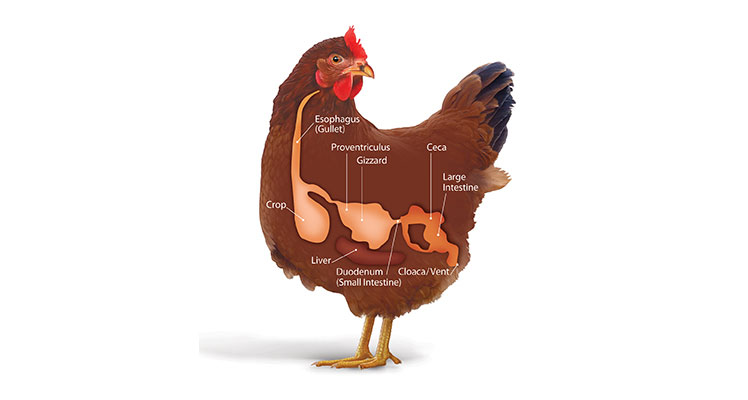The Poultry Digestive System

Instead of asking “Why did the chicken cross the road?” poultry hobbyists may better ask, “How does the chicken chew its feed without any teeth?” Even without teeth, chickens have one of the most efficient digestive systems in the animal kingdom. Let’s take a look at how the poultry digestive system works.
Food is taken in with the beak, which is the perfect tool for pecking feed in crumble or pellet form, small grains, grass or insects. Chickens are omnivores – meaning that, in addition to a commercial feed, they can eat meat (grubs, worms, the occasional mouse) and vegetation (grass, weeds and other plants). A small bit of saliva and digestive enzymes are added as the food moves from the mouth into the esophagus.
From the esophagus food moves to the crop, an expandable storage compartment located at the base of the chicken’s neck, where it can remain for up to 12 hours. The food trickles from the crop into the bird’s stomach (proventriculus or gizzard) where digestive enzymes are added to the mix and physical grinding of the food occurs.
The gizzard is why chickens do not need teeth. It is a muscular part of the stomach and uses grit (small, hard particles of pebbles or sand) to grind grains and fiber into smaller, more digestible, particles.
From the gizzard, food passes into the small intestine, where nutrients are absorbed. The residue then passes through the ceca, a blind sack along the lower intestinal tract, where bacteria help break down undigested food. From the ceca, food moves to the large intestine, which absorbs water and dries out indigestible foods.
This remaining residue passes through the cloaca where the chicken’s urine (the white in chicken droppings) mixes with the waste. Both exit the chicken at the vent, the external opening of the cloaca.
And don’t think of chicken manure as “waste” to be disposed of…it makes a great fertilizer for your flower beds or vegetable garden. Because it is high in nitrogen, it is recommended to let it age for a bit in a compost pile before adding it to your gardens.
A quick tour of the digestive system:
- Mouth: It all starts here.
- Esophagus (Gullet): Transports food from the mouth to the stomach.
- Crop: A pouch in the esophagus used to store food temporarily before moving it on to the stomach.
- Stomach (Proventriculus/Gizzard): Principally the organ where food is broken into smaller units. It has two parts: the proventriculus for storage and the gizzard. The gizzard is a muscular part of the stomach that uses grit to grind grains and fiber into smaller particles.
- Small Intestine: Aids in digestion and nutrient absorption. Composed of the duodenum, jejunum and ileum.
- Liver: The largest glandular organ in the body. Aids in the metabolism of carbohydrates, fats and proteins.
- Ceca: Bacterial action in the ceca helps break down undigested food passing through the intestine. The ceca turns into the large intestine, which connects with the cloaca.
- Large Intestine: Functions primarily to absorb water, dry out indigestible foods and eliminate waste products.
- Cloaca: Where the digestive, urinary and reproductive systems meet.
- Urinary System: Consists of two kidneys and two ureters. The kidneys are located in the pelvic bones. They filter waste from the blood and pass it through the ureter to the outside via the cloaca/vent.
- Vent: The external opening of the cloaca that passes waste to the outside.
